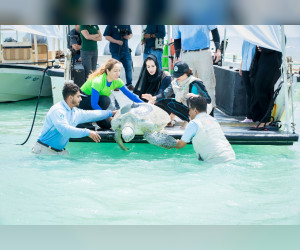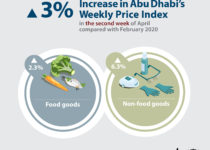Emirates Nature-WWF, and its partners, Environment Agency-Abu Dhabi, EAD, and the Marine Research Foundation, MRF, successfully managed to tag 36 turtles using satellite transmitters.
This was done to ensure that they belong to no single nation and that all nations have a shared responsibility to protect them and cohesively manage the seas.
Their findings, the first-of-a-kind in the Arabian Sea region, and one of only a handful of similar efforts worldwide were the result of ongoing research on the Gulf Green Turtle Conservation Project, announced to mark World Turtle Day, commemorated annually on 23rd May.
Recently, three of the turtles were tracked from their feeding grounds off Bu Tinah Island, Abu Dhabi, all the way to Oman where they mated, nested, and found their way back home to Bu Tinah Island. One of the tracked turtles left Bu Tinah Island in April 2018 and returned home on 19th December, following a perilous eight-month journey. She travelled upwards in the UAE, through Iran, then down south to the coast of Oman, where she mated and nested in the vicinity of Ras Al Hadd, a well-known green turtle-nesting site, hosting over 80 percent of all green turtles nesting in the region. Following her voyage, she retraced the same route and returned to the shores of Bu Tinah Island within a month, where she has since remained.
Jimena Rodriguez, Manager of the Gulf Green Turtle Conservation Project at Emirates Nature-WWF, said, “By recording a complete migration loop, we were able to better understand the ecological and conservation needs of green turtles, and the importance of the UAE in being a critical feeding site.”
Emirates Nature-WWF, alongside local and international partners, is developing a robust regional baseline of the ecological and conservational needs of green turtles, thereby applying science-based solutions to safeguard their survival.
Dr. Shaikha Salem Al Dhaheri, Acting Secretary-General of EAD, said, “Our past species-monitoring efforts have demonstrated that we have a large population of green turtles foraging in Abu Dhabi’s waters, but we had no record of them nesting here. Following the findings of this project, we will implement conservation initiatives, protecting the turtles’ nest and where they forage.”
Kick-started in May 2016, the Gulf Green Turtle Conservation Project continues to provide insightful data on the population, distribution, and behaviour of marine turtles and their habitats to identify migratory routes and important turtle areas for conservation.
Laila Mostafa Abdullatif, Director-General of Emirates Nature-WWF, said, “Contributing to the wider socio-economic development of the country and showcasing the human, ecological and economic benefits of conserving the marine environment, the Gulf Green Turtle project is a true testament to the vital need for partnerships, which strive to conserve the environment and encourage the community to live in harmony with nature and its many unique and diverse species.”







